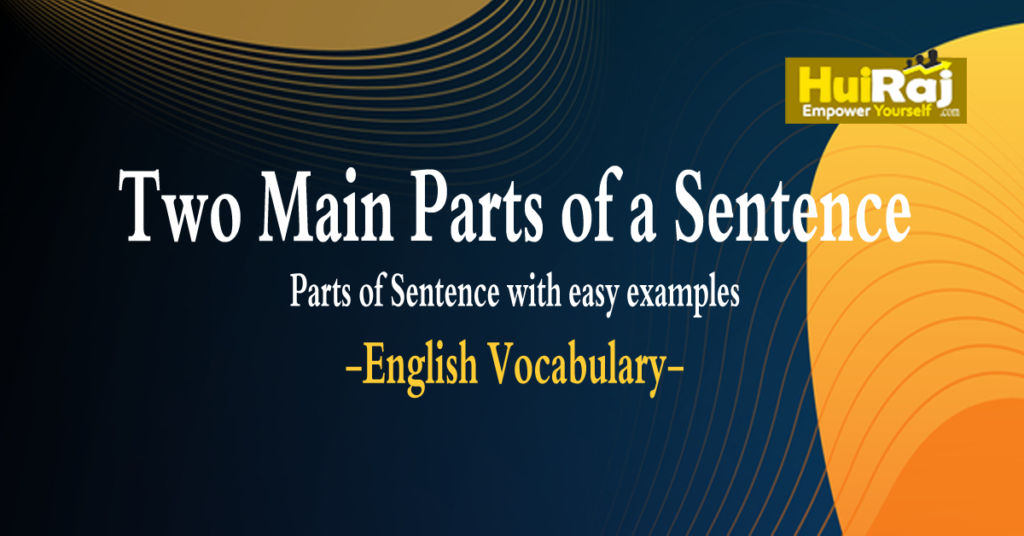What is Noun Phrase?
The words working as the subject in a sentence are called ‘Noun Phrase‘. The Noun Phrase is made of a noun or a group of words with a noun as its head. That means A Noun Phrase can have one word or more than one word.
Look at the sentences:
(A). Children play games.
(B) Our class teacher is a sincere teacher.
We can divide the above sentences into two parts- Subject and Predicate, as we have seen in Step-31
In sentence (A) “Children” is the Subject and ‘play games’ is the Predicate. Again in the predicate part, ‘play ‘ is the verb and “games” is the Noun Phrase. Similarly, in the sentence (B) “Our class teacher” is the Subject, and “is a sincere teacher” is the predicate. In the Predicate-part, “is” (be) is the verb, and “a sincere teacher” is the Noun Phrase.
We have seen in [Step-31 / (Subject with one or more words)] that the word(s) used as the subject of a sentence is a Noun Phrase. So a Noun Phrase can occur in the subject part as well as in the predicate part.
Examples of Noun Phrase
- The girl ate the mango.
- The pretty girl ate the mango.
- The pretty little girl ate the mango.
Here the bold with italicized words are Noun Phrases. Each Noun Phrase is a group of words (e. g. the pretty girl/the mango, etc). But, in the sentence (A), Children and games are one-word Noun Phrases. So, A Noun Phrase can have one word or more than one word. In sentence (A) Children and games are the Head Nouns. But in sentence (B), ‘teacher’ is the Head Noun in both the subject and the predicate parts.
What is head noun?
In sentences (1) (2) and (3) ‘girl’ is the Head Noun in each of the Noun Phrases in the Subject Part and ‘mango’ is the Head Noun in each of the Predicate Part. The Head Noun usually occurs at the end of a Noun Phrase (e.g. ‘our teacher, ‘’ a sincere teacher, the pretty little girl, or the mango, etc.)
More Examples of Noun Phrase
(4). Everyone in the family knows me.
(5). A boy of fifteen is a problem child.
In sentence (4) ‘Everyone in the family is Noun Phrase or in short, we say an NP. In this Noun Phrase “Everyone’ is the Head Noun. In the sentence (5) ‘A boy of fifteen‘ is a Noun Phrase and ‘boy’ is the Head Noun. Sometimes the Head Noun can also occur at the beginning or at the mid-position of a Noun Phrase like ‘everyone’ and ‘boy’ in sentences (4) and (5) respectively.
Pronoun as Noun Phrase.
6. (a) Ram is in class nine. He plays cricket every day. (b) Lions are wild animals. They live in the forest.
Here in the above sentences He and They are PRONOUNS. ‘He’ and ‘they’ are used as Subjects in these sentences. ‘He’ is used for the Noun Phrase ‘Ram’, and ‘they’ is used for the Noun Phrases (Lions). So, “he” and “they” are Noun phrases.
Extra note for Pronoun for noun phrase
A pronoun may be one of the seven so-called PERSONAL PRONOUNS ( I, you, he, she, it, they, we ) or INDEFINITE PRONOUNS like everyone, anyone, someone, something, or DEMONSTRATIVES like this or that. A pronoun is a PRO-FORM, i.e. a form instead of another form. Pronouns, on the other hand, are sub-class of Nouns. We also call them Noun Phrases.
The object of the sentence as Noun Phrase
7(a) The teacher gave Rasmika a book.(b) The teacher gave her a pen.
In the above sentences ‘Rasmika’ is a Noun Phrase and it is used as the OBJECT of the Verb ‘gave’. We can use the Pronoun ‘her’ in place of “Rasmika”. Here, ‘her’ is the object form of the pronoun ‘she’. So, it is also a noun phrase.
Exercise 1 for Noun Phrase
Pick out the Head Noun in each of the Noun Phrases:
- The earth moves around the sun.
- Sankar is away.
- One day a rat saw a cat.
- I saw Rasmika.
- Do you like apples?
- Those are lovely drawings.
- Who has seen my keys?
- Flowers are beautiful.
- Elephants are docile.
- That tall girl has a bicycle.
- The Chinese and Japanese are hard workers.
- There is not much ink in the bottle.
List of words that go before the Head Nouns.
Following are the words that go before the Head Noun.
- Articles
- Possessives
- Demonstratives
- Ordinals numbers words
- Quantifiers
- Adjectives
- Noun
Use of Article before Head Noun
07. She has got two children: a boy and a girl. The boy is nine and the girl is six.
08. Krishan bought an apple. The apple was good.
08. I saw an elephant. The elephant was big.
The words A/AN, and THE are ARTICLES.
While referring to a person (boy/girl) or a thing (apple) for the first time a/an (a boy/ a girl/ an apple/ an elephant ) is used. While referring to the same thing or person again, the ( the boy/ the girl/ the apple, the elephant) is used.
Note
The article ‘the’ is used when the identity of the noun (boy/girl/apple, elephant ) has already been established. So it is called the DEFINITE ARTICLE. A/an is called the INDEFINITE ARTICLE.
Some other uses of ‘the’ are dealt with in the Step-46 and Step-48.
Use of Adjective before Head Noun
Let’s study the following sentences:
09. The rose is a beautiful flower.
10. He is an intelligent boy.
11. That is a wide road.
13. This is a big garden.
14. The blue pen is mine.
The italicized bold words are ADJECTIVES. They are used before the nouns (flower/boy road/pen/garden). Study the sentence 09 again. A beautiful flower is a Noun Phrase. “Flower” is the Head Noun. “Beautiful” is an Adjective, because it describes the noun ’flower’. Other adjectives used in sentences 10, 11, 12, and 14 (intelligent/wide/blue/big) also describe the nouns (boy/ road/pen/garden).
Use of Ordinal Numbers and Cardinal Numbers before Head Noun
Let’s look at the sentences given below:
15. She won the first prize in the competition.
16. Did you catch the second train to Puri?
17. India needs two runs to win the match.
The words first and second in sentences 15 and 16 are used before the nouns (prize and train). They are called ORDINAL NUMBERS. First is related in meaning to one and second to two. But in sentence 17, “two” is used before the noun ‘runs’ in the Noun Phrase ‘two runs’. Numbers such as one, two, etc are called CARDINAL NUMBERS.
Use of Possessive before Head Noun
Look at the following sentences;
18. This is my shirt.
19. That is Gita’s frock.
Here my and Gita’s are used before the head nouns shirt and frock respectively. They show possession. So we call them POSSESSIVE.
Use of Demonstratives before Head Noun
Look at these examples:
20. This pen is red.
21. That girl is Pavani.
22. These flowers are beautiful.
23. Those bananas are good.
In the above sentences, this, that, theses, and those are used before the head nouns pen, girl, flowers, and bananas respectively. They are called DEMONSTRATIVES. This and that are used when we point out a particular thing/person: and these and those are used when we point out particular things/persons.
Use of QUANTIFIERS before Head Noun
Study the following examples;
24. Some notebooks are lying on the table.
25. All horses are animals.
26. There were a few people in the meeting.
27. There is a little milk in the glass.
28. There is not much sugar in the tea.
29. Two boys have broken the table.
The words some, all, a few, a little, much, and two are AMOUNT WORDS. (Two, as we learned earlier, is also a number word.) These words determine the quantity of the nouns (notrbooks/horses/people/milk/sugar/boys). So these amount words are called QUANTIFIERS. Some other Quantifiers are many, several, few, little, enough, both, and half, etc.
Now look at the following chart/diagram. We can mark the words that come before a head noun in a Noun Phrase.
NOUN PHRASE
Articles —>Possessives— >Demonstrative—>Ordinal number words—>Quantifiers—> Adjectives—>Noun.
Exercise 2 for Noun Phrase
Identify the words that come before the Head Noun in the Noun Phrases given below.
- A friend in need is a friend indeed.
- The girls were at play.
- There are some mangoes in the basket.
- There isn’t much water in the bucket.
- There aren’t many police in this town.
- The farmer has three heads of cattle.
- A horse can run faster than a camel.
- These lemons are sour.
- There is some egg on your chin.
- All these four children are my friends.
- We want more plain paper to do the exercise.
- That black goat is ours.
- The first boy in the line is Suvendu.
- Everybody’s business is nobody’s business.
Exercise-3 for Noun Phrase
Fill in the blanks by adding as many words as possible of these words (A, an, the, this, that, your, his, her, Beautiful, black, first, little, big). See the example given below.
Example: That black dog is faithful.
- Yesterday I saw __________ film.
- I don’t like __________ town.
- Will you send me __________ postcard?
- __________ bird is mine.
- We enjoyed __________ picnic very much.
- The postman gave me __________ packet.
- This is __________ train to Hyderbad.
- Send me __________ letter, please.
- Our school has __________ building.
- Is this __________ pencil?
Exercise 4 for Noun Phrase
Now complete the following story with (a/an, the, a few, a lot of, some). You can use them more than once.
Many years ago ____________ young prince who lived in beautiful castle told his father, I want __________ wife who should be pretty but should also be __________ real princess. “You are right, “said __________ mother, “ Only __________ real princess should be your wife. “ So __________ princes went in search of __________ real princess from place to place. It was very difficult to find __________ real princess. So he was very sad. And after __________ months he came home feeling very unhappy . Just that night the prince’s servant heard __________ knock at __________ door. When he opened it, he saw __________ young girl. With __________ confidence, the girl said to __________ servant, “take me to __________ prince at once. I am Princess Mary”.
__________ servant asked her to come into __________ house and wait in __________ large hall.
The prince welcomed her and told __________ servants to give __________ princess __________ water to drink and __________ comfortable bed to sleep on. Without letting __________ princess know his plans, he told __________ servant to put__________ small hard pea under __________ mattress. When he met __________ princess in the morning, he asked her, “ Did you sleep well?” “ Oh, no, ‘ said __________ princess. “ There was something hard in my bed and so I could not sleep __________ wink.

